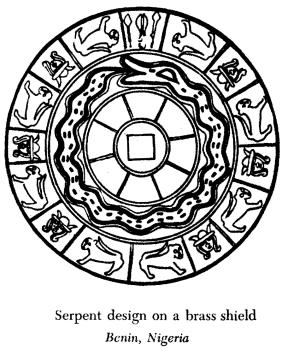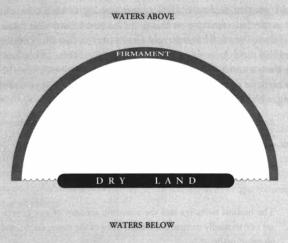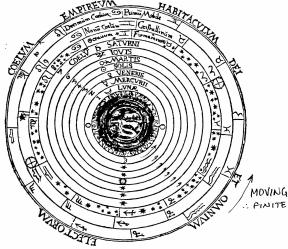Shifting Pictures of the UniverseA. TraditionalBelow is an example of one kind of the many kinds of traditional
representations of the universe and of time: the snake swallowing its
tail. It is a symbol that one finds all
over the world.
A. Traditional Uroboros (snake swalllowing its tail) B. BiblicalThis is a representation of the cosmos of the ancient Near East, the Genesis cosmos. It is a three part picture: the heavens, the flat earth, the
underworld. As it is described in Genesis, God separated the waters,
providing a space. The firmament held
up the upper waters, making space for dry land where animals, plants, and
people could find a home. But the firmament
had the possibility of breaking, and in the Noah story, the “chimneys” in the
firmament and the “fountains” of the deep open up. The Flood was understood as not just a rainstorm but a cosmic
catastrophe, a threat to recreate the primordial chaos.
B. Biblical C. MedievalThe Medieval picture is based on the Ptolemaic and even earlier
Platonic and Aristotelian conceptions of the crystalline spheres, with the
spherical earth at the center and the whole pattern of spheres revolving around
the earth every day. The spheres also
revolve slowly against each other. The
innermost sphere carries the moon, and then Mercury and Venus and the sun (with
Mercury and Venus closely linked to the sun).
Beyond the sun were Mars, Jupiter, and Saturn (the Seventh Heaven), the
fixed stars, and then angels.
C. Medieval D. NewtonianGalileo’s observations with
the telescope provided the first convincing evidence that the Ptolemaic picture
was wrong. This pulled the rug out from
the entire Medieval conception of a hierarchical structure of the universe -
including the human universe.
Galileo’s work, published in
Italy in 1610, spread quickly throughout Europe. Already in 1611 in England John Donne writes:
Such was the impact of this change in cosmology. What was the new
picture? The Newtonian cosmos replaced
the Medieval picture. There is simply
empty space, the void, stretching on indefinitely in all directions. In the Middle Ages, when one went out at night
and looked up, one saw majestic height, not infinite vastness. The statement in Pascal’s Pensees, “the
eternal silence of these infinite spaces alarms me,”
D. Newtonian E. Modern?Our modern conception bears some elements of all these pictures, but it is very different from all of them. Let me start by summarizing the differences between the Medieval, Newtonian, and modern pictures. The Medieval cosmos is of finite size, it
began a finite length of time ago - which could be calculated by adding up the
begats in Genesis - and it was
geocentric. The physical part had to be
finite in size because the whole thing goes around once every day. There’s a distinction between the material
contents of the sublunar world and of the perfect, unchanging heavens.
The unifying ideas are constant circular motion and the Great Chain of
Being: Newton argued that if the cosmos were finite,
then everything would fall to the center, In the modern cosmos, we know how big the visible universe is, about 1028 centimeters (cm) - that distance is called the “cosmic horizon.” We know how long ago the universe started - about 14 billion years ago. We know that on large scales, It is homogeneous and isotropic (the same in all directions). It is made of atoms, dark matter, and radiation. Gravity is curvature of spacetime and can create horizons, and nondeterministic quantum mechanics and evolution are the key ideas. It is not clear whether there is a role for God.
Contributed by: Joel Primack and Nancy Abrams |










